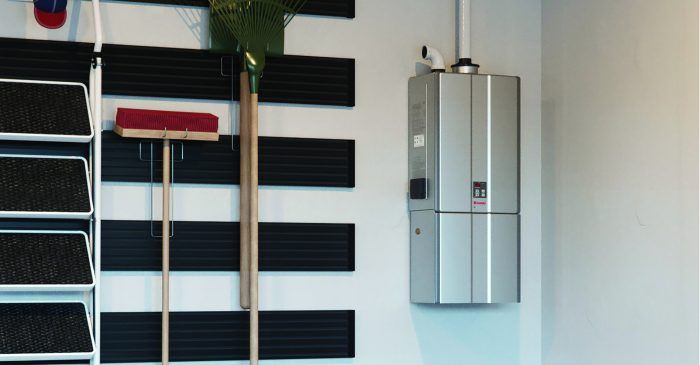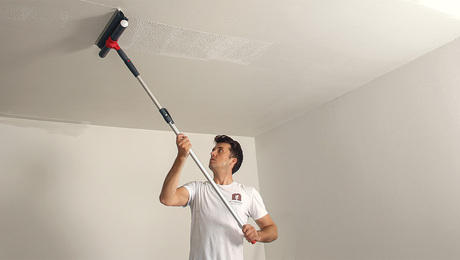Understanding Tankless Water Heaters
Tankless heaters don't take up much room, and they don't waste energy on hot water you're not using.

A standard water heater is a simple appliance with two main components—a heat source and a storage tank. From an energy-efficiency standpoint, the way they work together is a problem. Water sitting in the tank is maintained at its set point until it’s needed. This takes a steady supply of energy, even when no one needs hot water.
This fundamental inefficiency is what makes tankless water heaters so attractive. Instead of keeping a tank of hot water at the ready, a tankless model heats water only when it’s needed. There is no storage tank, and no energy losses (what the industry calls “standby losses”) that go with it. When water begins flowing, the water heater turns itself on. Turn off the faucet and the water heater shuts itself off. Manufacturers say they can cut water-heating bills significantly.
There are at least two other advantages. Assuming that you’ve sized the water heater correctly, it will produce all the hot water you need to keep a houseful of guests happy. You won’t run out. Plus, tankless water heaters take up less room than a tank-style heater. Some models may even be installed outside.
The mechanics of a tankless heater are much more complex than those of a conventional water heater. There’s a water-flow sensor, a copper heat exchanger, a cold-water bypass to adjust the temperature of the outgoing water, a temperature sensor, and a printed circuit board that monitors a variety of functions. This is one reason they tend to be more expensive than conventional water heaters.
Gas and electric models
Tankless water heaters can be powered either by gas or by electricity. In most cases, a gas-fired model is more practical. Electric models can consume prodigious amounts of power. For example, Rheem’s Performance 36kw model has a flow rate of 5.5 gal. per minute, enough for two showers running simultaneously. But it’s rated at 150 amp—three-quarters of the total capacity of a 200-amp main panel, which is standard in most houses these days.
Just like gas-fired water heaters with a storage tank, tankless models come in condensing and non-condensing versions. Condensing heaters are more efficient. They extract more heat out of a given amount of fuel, operating at efficiencies of 90% or better. And because flue gases are that much cooler, they can be vented with plastic pipe rather than a masonry chimney.
Choose the right size
There are a few bits of information you’ll need in order to figure out what model is best: how much hot water will be drawn at the same time (in gallons per minute, or gpm), and the temperature of the water entering the house.
Suppose you want to run two showers at the same time. The maximum allowable flow rate for a showerhead is 2.5 gpm, so two showers will require 5 gpm. Kitchen faucets have an average flow rate of about 2 gpm; bathroom faucets are somewhat lower. In this situation, a 7-gpm flow rate should be enough for two showers and someone scrubbing pots at the kitchen sink.
Ground-water temperature also is a factor. Tankless heaters have to boost the temperature of incoming water rapidly, so the colder the water that’s coming into the heater, the lower the output of hot water. Manufacturers describe the difference between input and output as the “temperature rise.” A tankless heater makes much less hot water at a given set point when the groundwater temperature is 35°F than it does at 70°F. Details will be in the specs for a particular appliance.
Don’t forget maintenance
How much maintenance a tankless water heater will need depends on water quality. Rinnai recommends checking the in-line screen filter once in a while, plus a period flush to remove scale and lime. These are jobs most homeowners should be capable of taking care of, but if you’re not interested, count on hiring a plumber to take care of it for you. Ignoring these issues may shorten the life of the heater.
Keep in mind that tankless heaters are not instant water heaters. You’ll still have to wait for the water to get from the appliance to the faucet or shower. If you want an instant water heater, install one of those at the point of use.
More about water heaters:
Heat-Pump Water Heaters – Higher efficiencies than electric-resistance heaters will save money, but upfront costs are higher.
How to Install a Tankless Water Heater – Pluses include endless hot water and a compact design, but the installation means a lot of pipes in a small space.
Tankless Water-Heater Maintenance – A little cleaning can help tankless water heaters perform like new.

























View Comments
Ah, the brave not-so-new world of unlimited hot water on demand, and high-efficiency condensing heaters. Here are some additional considerations:
1) The feedback control loop is more complex, no doubt depending on a proprietary control board. Proprietary means hard for a talented plumber to diagnose- need a laptop with proprietary diagnostic software and proprietary connector? Care to decode hex? Bad control board? Proprietary means very expensive.
2) Condensing heaters are relatively more sensitive to input water quality. Mineral content will foul complex control components. Given the amount of power needed to achieve 5 gallons + per minutes, the computer is set to fail-safe. Bad sensor? You are in shut down mode. Which sensor? There are several. The hex code will tell you. Old fashion tank heaters are most robust to minerals- some failure modes give a gradual warning in time to take action.
3) Can't have a 150 AMP demand electric model? Gas condensing heaters output a brew of acids not friendly to waste pipe, in particular cast iron. Buried cast iron.
4) Homeowner maintenance? Seriously? Have you even read the boilerplate on even an old-fashion tank heater? OK, so the manufacturer is legally protected. It's your fault. Neglect maintenance, and that condensing line will clog- and the computer shuts you down quick.
5) So what's next, an app so Siri can tell you about your heater? How many points of failure in that chain? Wi-fi. The internet. The app server. Your smartphone.
I am an engineer. I love tech. I took classes in energy conservation. It's important. But I spend a lot of time fixing computer controls. Last winter, a blizzard caused the power at my house to fluctuate; that tripped the board, and the boiler fails safe. No heat. Holiday. No tech support. Dug a path through the snow to the boiler room. No online support- it's proprietary! My friend and good-guy plumber has no clue. Got through with the gas log fireplace.
Advice: 1) consider Total Cost of Ownership, not just marginal energy savings (if you bang out 150 AMPs you may get a demand charge on top of your energy charge); and 2) consider System Reliability of critical components to run your house. Computers are powerful tools, but heat is important- are you OK with no service during a winter storm? How about holidays and weekends?